A complete guide to making Chinese bao buns with a fool-proof method. It includes many tips and troubleshooting FAQs that help you make them without fail.
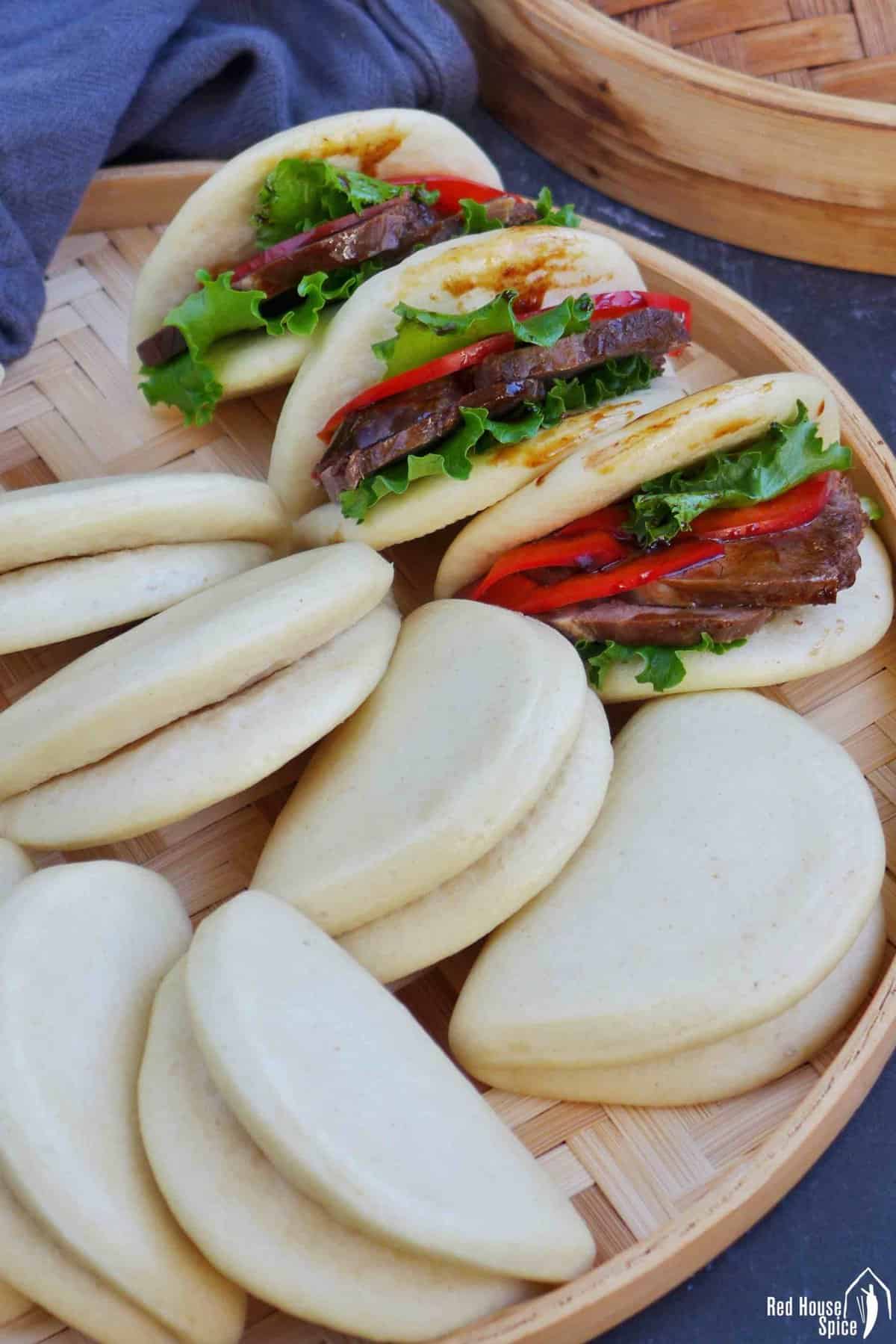
What are bao buns
Broadly speaking, bao buns (or simply “bao/包”) refer to a type of Chinese food made of wheat flour-based, leavened dough filled with savory or sweet fillings. They are mostly steamed but can be pan-fried or baked too.
From savory ones like Steamed Pork Baozi, Char Siu bao, Sheng Jian Bao to sweet ones like Custard Buns, Red Bean Buns, Chinese bao buns are adored by many. They stand out for their fluffy, soft texture and neutral flavor which are quite different from Western-style bread.
This guide is dedicated to steamed, folded bao buns which are the simplest type to make at home. Unlike other types, such as the classic Baozi which come in pleated patterns and with sealed fillings, this version of bao buns is made of the same kind of yeast dough but wraps around the filling like how Mexican tacos work.
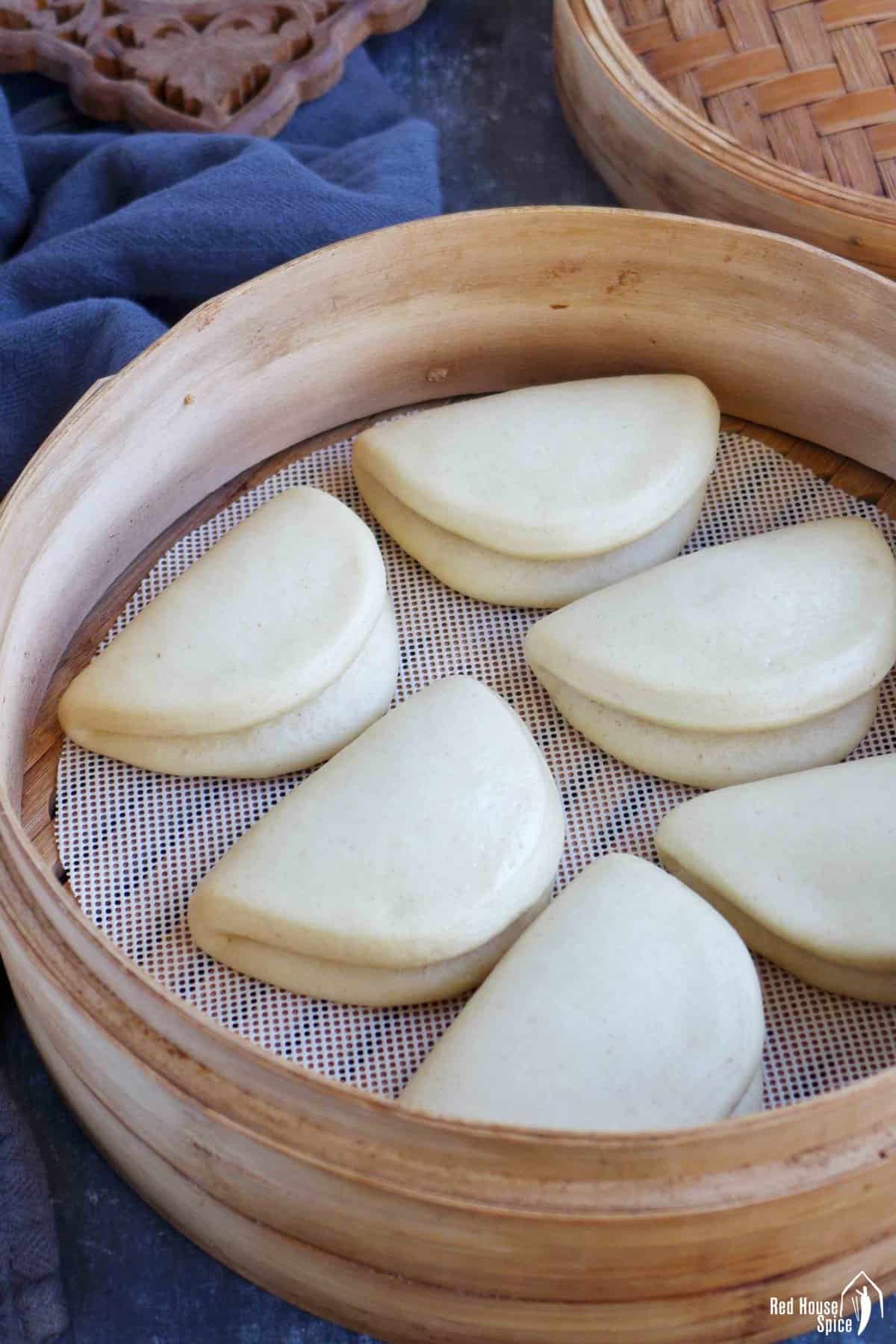
Basically, they’re flattened dough folded into a half-circle shape. After steaming, they’re opened up to wrap a variety of fillings (mostly savory but can be sweet) for serving.
In Chinese, they are known as Gua Bao (割包/刈包) or He Ye Bing (荷叶饼) if pressed with a few lines to imitate the look of a lotus leaf.
Why this recipe
What makes this recipe foolproof? You may ask. Because it doesn’t follow the traditional, yeast-only approach which can be problematic for those who aren’t familiar with dough proofing.
- Instead, this recipe uses both yeast and baking powder as raising agents, like how I make Mantou (plain steamed buns) and Hua Juan (steamed flower rolls), two popular recipes proved by many of my readers.
- This method largely reduces the proof time (only once for 30 minutes) and consistently produces good results.
- Also, I’ve included two dough-making methods, two bun-shaping techniques, and many tips in this post. The FAQs section at the end answers many questions that I’ve previously received on this topic.
Equipment
For this bao bun recipe, you’ll need:
- A bamboo steamer (or metal/plastic ones). An alternative method without a steamer is explained in the “how to steam” section.
- Steamer basket liners (skip if using oil to prevent sticking)
- A mixing bowl if making dough manually, or a stand mixer with a dough hook.
- A rolling pin, and an optional large round cutter
Ingredients for the dough
To make bao bun dough, you’ll need the following ingredients:
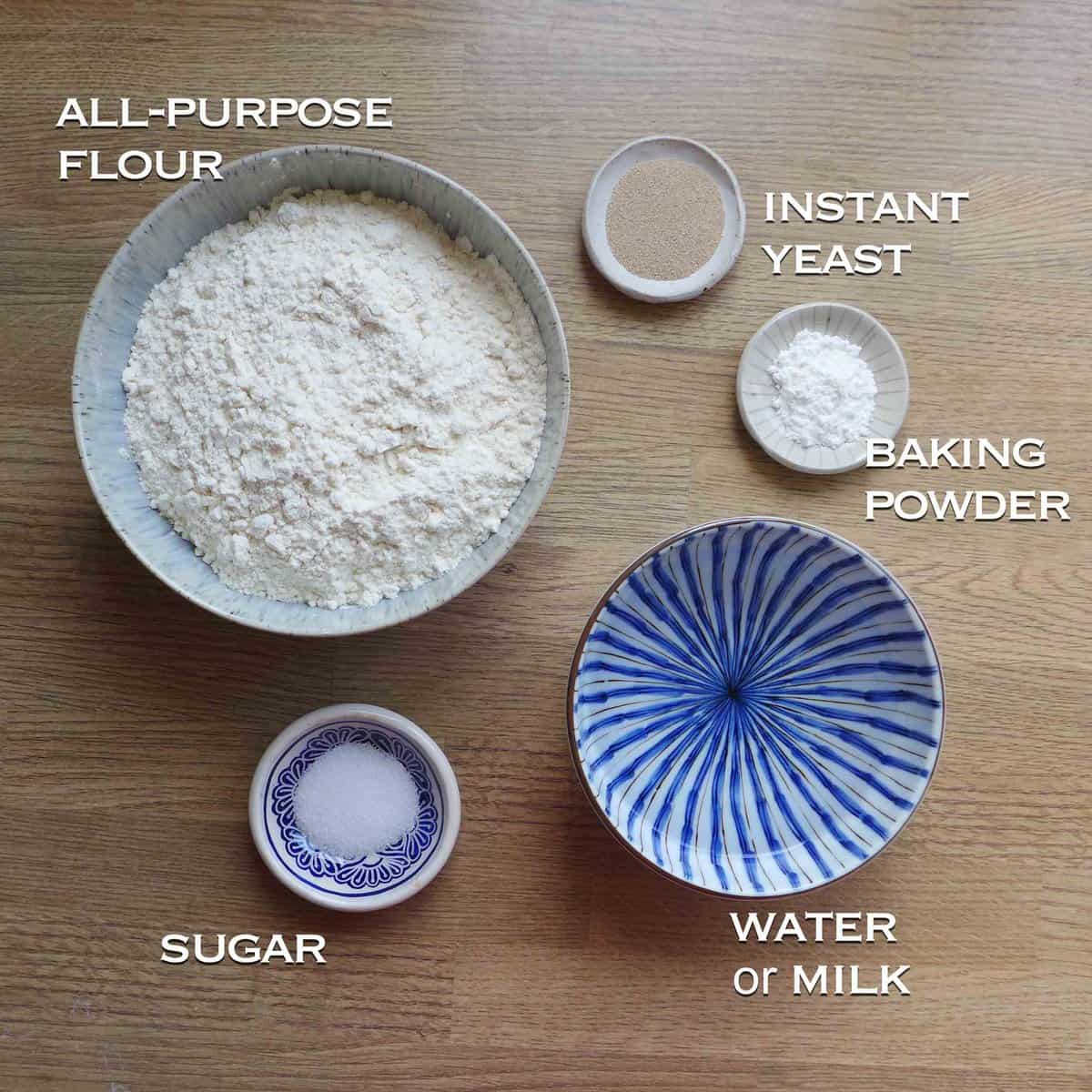
- All-purpose flour (aka plain flour)
- Instant yeast, or active dry yeast, fresh yeast
- Baking powder
- Sugar
- Water or milk (lukewarm)
Which type of flour
White wheat flour that has a low to medium gluten content works best for bao buns.
- I usually use all-purpose flour (aka plain flour) since it’s the most accessible type and has a medium gluten level (9-12g protein per 100g flour).
- If you’re looking for the fluffiest buns, use cake flour which is low in gluten.
- Bread flour, which is high in gluten, is acceptable but it results in a chewier texture. You can replace ⅕ of the bread flour with cornstarch to lower its gluten level.
- If you want your bao buns to be as white as the shop-bought ones, use special bao flour (available in some Chinese stores) which is bleached and highly processed.
Which type of yeast
Unlike Chinese dumpling dough which only calls for flour and water, yeast is essential for leavened dough like this one. It makes the dough rise and become fluffy while steaming.
I always use instant yeast (aka easy bake/blend yeast, fast action dry yeast, etc.) for its convenience and consistent performance. It has a very fine texture and can be added directly to the flour and mixed with water.
Other types of yeast, such as dry active yeast (made of small granules) or fresh yeast (comes in blocks), work fine for this recipe too. But you’d need to slightly alter the mixing method (see instructions in the recipe card below).
Why baking powder
Traditionally, yeast is the only raising agent used in Chinese bao buns. This method requires double proofing which takes a long time and can be tricky if you aren’t familiar with proofing evaluation.
Adding baking powder, another type of leavening agent, makes the whole process a lot faster and easier. Only one proof is required and the result is much more consistent.
Water or milk
Either water or milk can be used for bao dough (or use a mixture of both if you like). Milk tends to produce a softer, fluffier texture thanks to its fat content. If you’d like to achieve this but you’re lactose intolerant, replace 1 tablespoon of water with neutral-flavored cooking oil.
Ingredient ratio
I recommend you use a kitchen scale when it comes to dough making (especially if you aren’t familiar with this topic). Measuring flour with cups can be problematic as the accuracy isn’t guaranteed.
The chart below explains how much of each ingredient you need to make about 8-12 bao buns (depending on your preferred size).
| INGREDIENTS | QUANTITY |
| All-purpose flour | 300g |
| Instant yeast | 1¼ teaspoon |
| Baking powder | 1 teaspoon |
| Sugar | 1 teaspoon |
| Water or milk (lukewarm) | 165g |
🛎 Notes:
- The flour-to-water ratio may vary slightly as flour of different brands has different water absorption capacities. The humidity level of your kitchen also matters a little. Adjust if necessary. The dough should be medium soft but not at all sticky.
- If using bread flour, you’d need a little more water as it has a higher gluten content.
- If using dry active yeast, the quantity remains the same. For fresh yeast, please refer to the recommended quantity on the package.
- Sugar is to help the leavening process. It’s fine to omit it or slightly increase its quantity if you prefer a sweet taste.
Prepare the dough
You can make the dough either manually or in a stand mixer with a dough hook attachment. Both ways are straightforward. I’ll first explain how it’s done using instant yeast. Methods using dry active yeast and fresh yeast are explained in the note below.
Option 1: Manual method
- Add the dry ingredients (flour, instant yeast, baking powder and sugar) to a large bowl. Mix well then pour in lukewarm water/milk gradually while stirring with chopsticks or a spatula.
- Then use your hands to combine the lumps to form a rough-looking dough ball. During this process, add a little water or more flour to adjust if necessary.
- The dough should be soft to the touch but doesn’t stick to your hands at all.
- Cover the dough and leave it to rest for 10 minutes or so. Then knead again (for about 2-3 minutes) until the dough becomes very smooth on the surface.
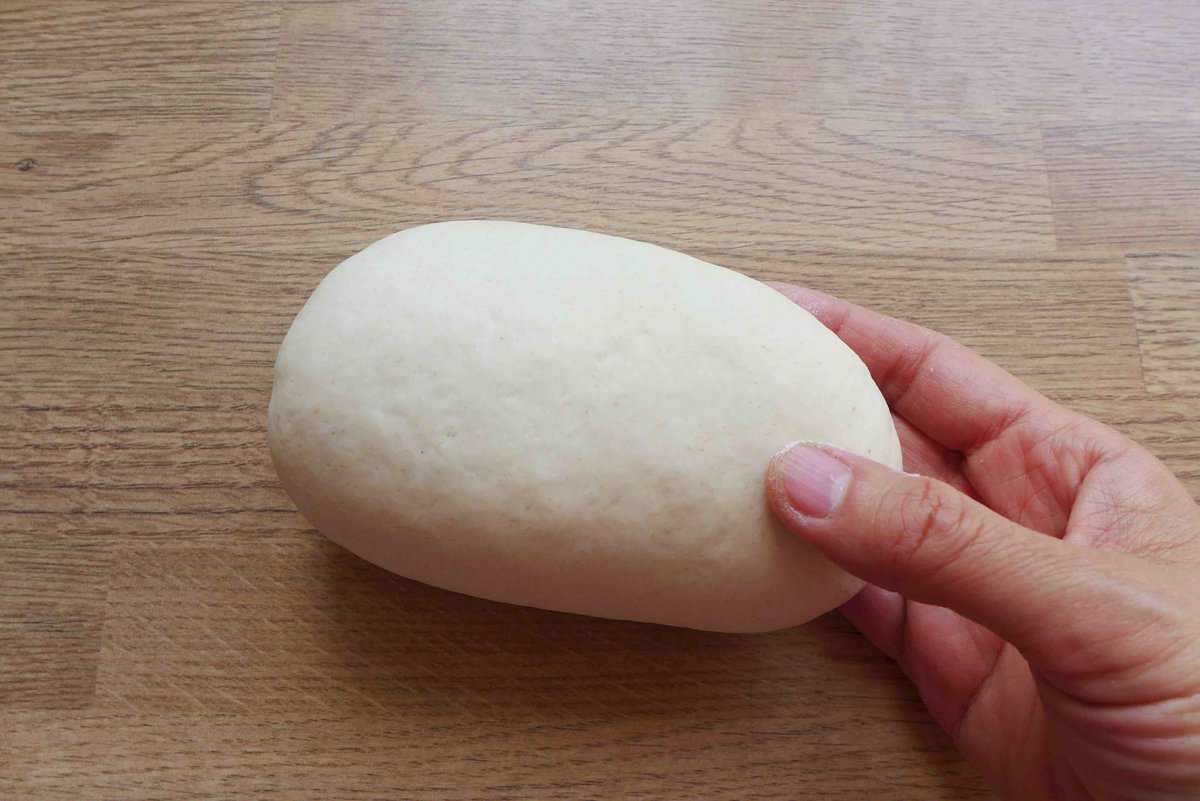
Option 2: Stand mixer method
- Add all the dry and wet ingredients to the mixing bowl. Use the dough hook attachment to mix and knead on low speed for 8-10 minutes.
- Take out the dough and manually knead a few strokes to finish.
🛎 Note:
If using dry active yeast or fresh yeast, you’ll need to mix it with sugar and warm water/milk. Let it sit until the liquid becomes foamy. Then pour the yeast mixture over the flour and baking powder mixture then move on to the kneading procedure.
Shape the bao buns
Unlike working with yeast-only dough that needs proofing before shaping, you should start making the bao buns straightaway. I’d like to introduce two different shaping methods so you can choose the one that suits you better.
For both methods, remember to dust your work surface and the rolling pin with flour to prevent sticking.
Method 1: Rolling
This method is similar to how you make Chinese dumpling wrappers. Each bao bun is rolled out individually.
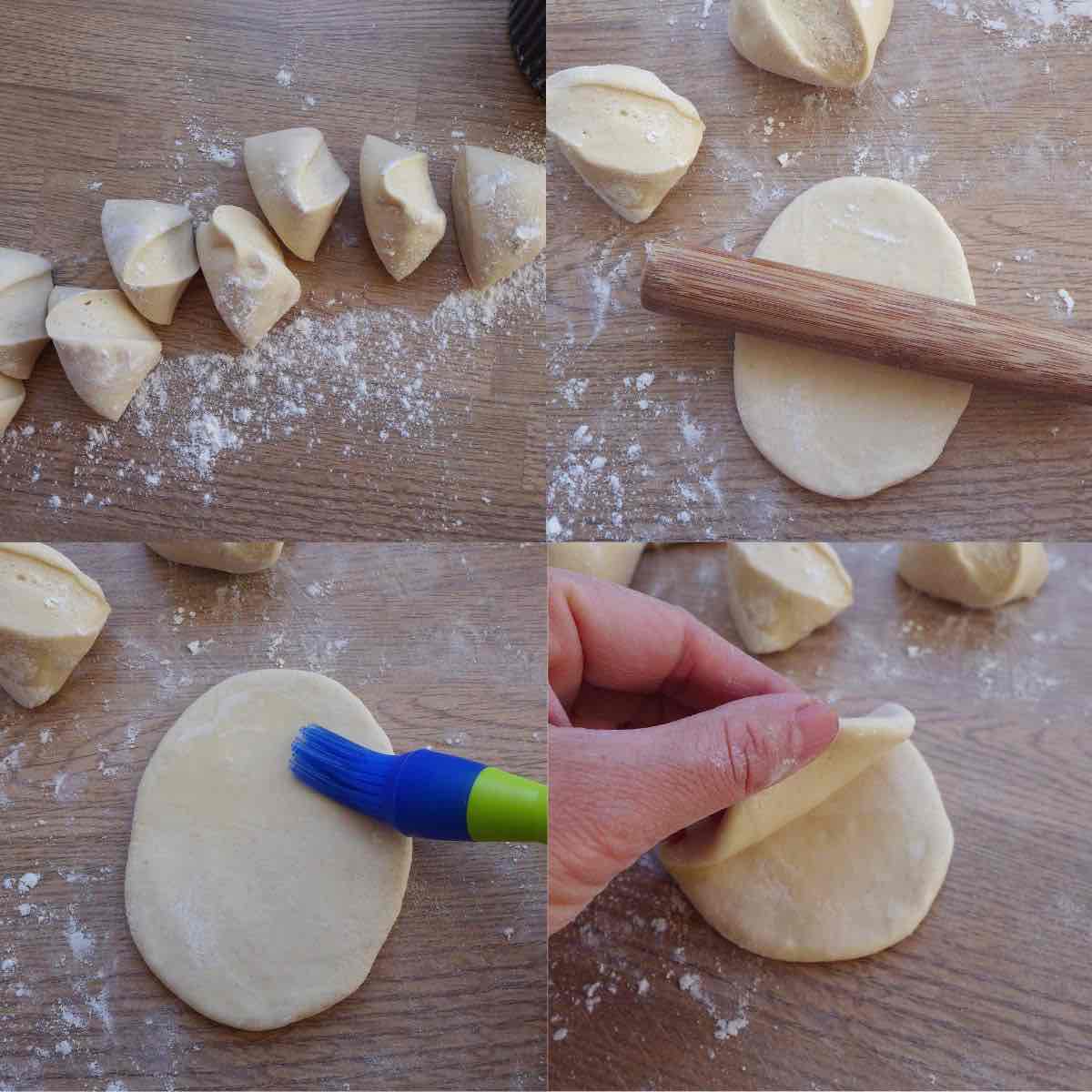
- Roll the dough into a rope. Divide it into 8-12 equal sections.
- Press each piece into a disc with the palm of your hand.
- Use a rolling pin to flatten it into an oval shape.
- Brush a very thin layer of oil over half of the surface then fold the oval lengthways.
Method 2: Cutting
You’ll need a large, round biscuit cutter for this method.
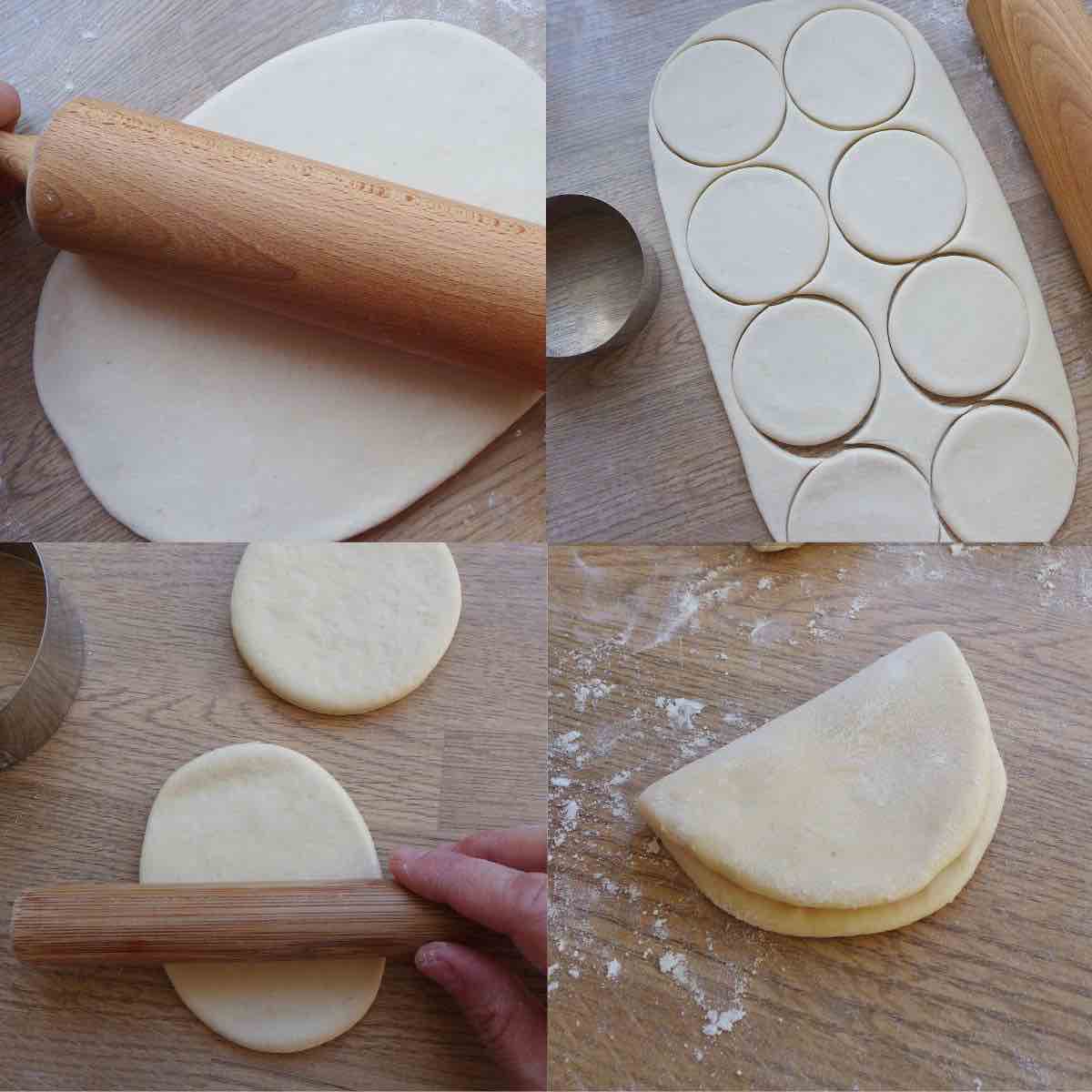
- With a rolling pin, flatten the dough into a rectangle shape, about ⅕ inch (½ cm) thick.
- Cut out circles with the biscuit cutter. Then stretch each circle into an oval shape with the rolling pin.
- Gather and knead the leftover dough. Repeat the procedure to make more.
- Brush a very thin layer of oil over half of the oval then fold over.

🛎 Note:
The oil is there to prevent sticking. Alternatively, place a small piece of parchment paper in between the folded dough.
A single proof
Once all the bao buns are shaped, place them in the steamer baskets lined with steamer parchment paper or brushed with a thin layer of oil (I use silicone steamer liners). Make sure there is enough space in between the buns as they’ll expand after steaming.
Leave them to proof for about 30 minutes. They will raise a little during this process. They become visibly plumper but won’t double in size. Also, they feel much lighter than unproofed dough (The images below show how the buns change after resting).
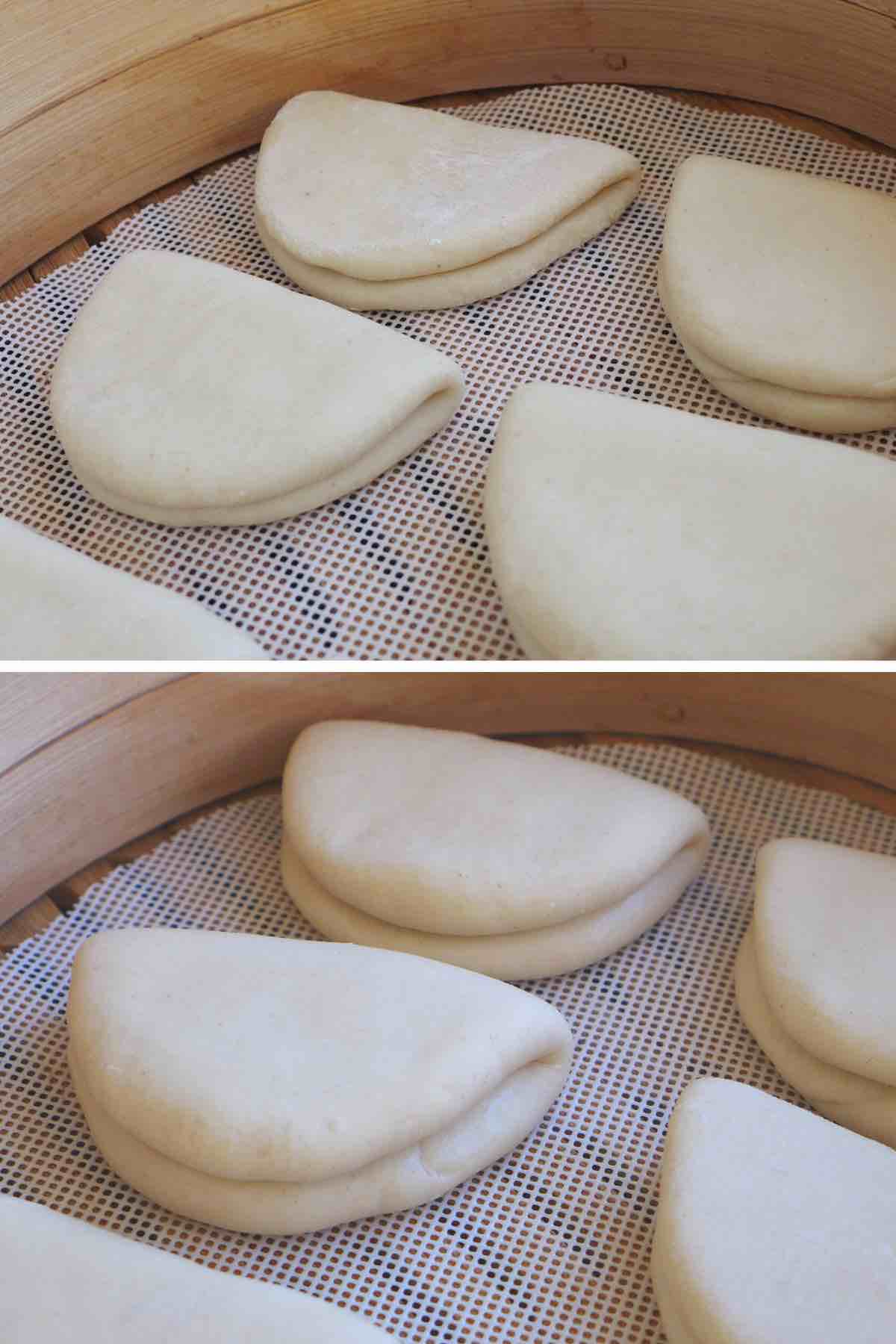
🛎 Note:
The proofing time required may vary depending on the room temperature. It takes me about 30 minutes when it’s around 72-77°F (22-25°C). Slightly reduce the time if your kitchen is warmer, or prolong it a little if it’s cooler.
Try not to overproof as it will result in bubbles on the surface after steaming.
How to steam
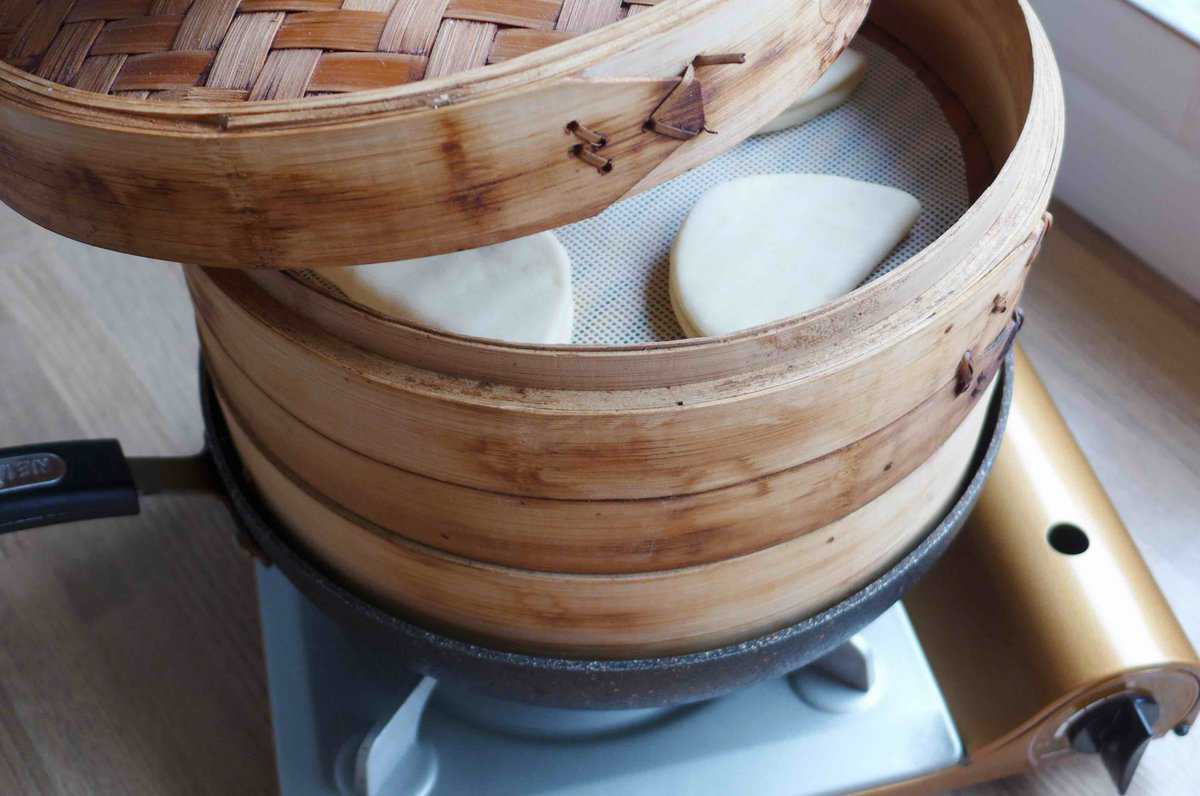
Add 2 cups (500ml) of water to a wok/pot then place the baskets on top. Cover with a lid. Start with high heat to boil the water.
Once it starts boiling (you’ll see steam escaping from the gaps), turn the heat down to medium-low. Count 10 minutes from this moment. Then you’re ready to serve them warm with fillings of your choice.
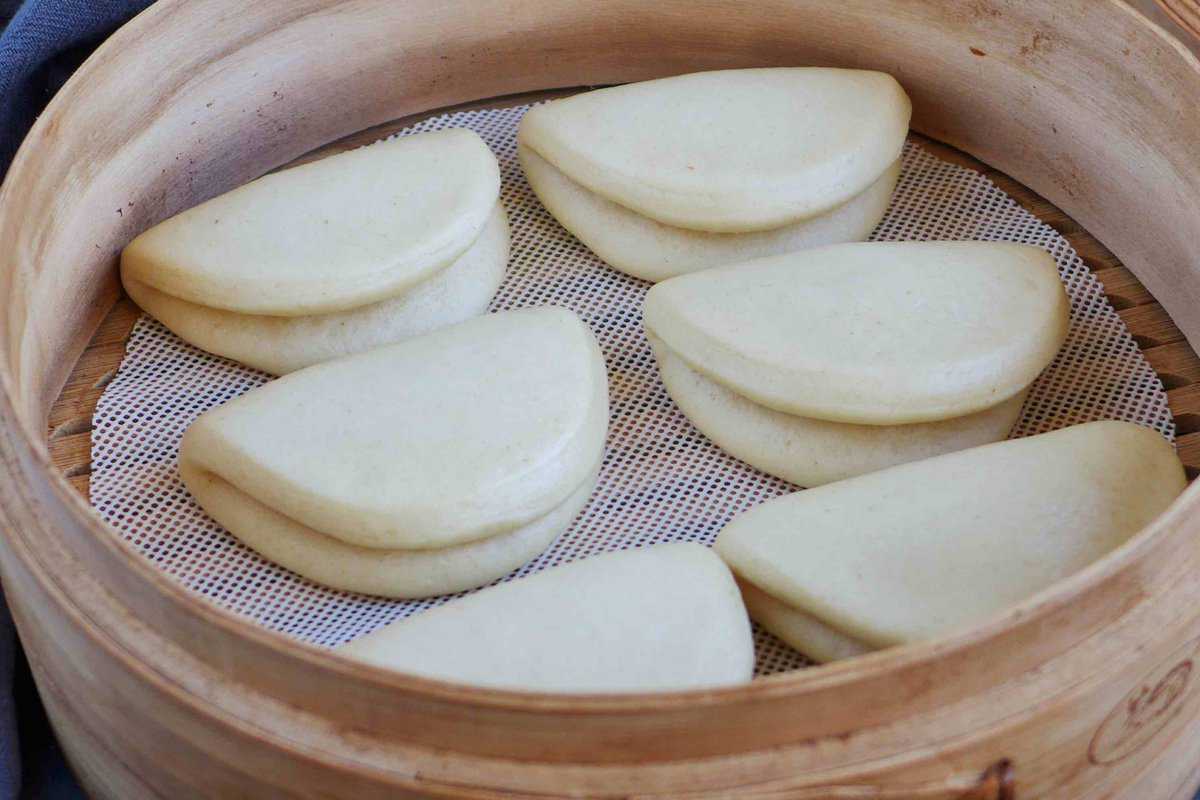
🛎 Notes:
- Bamboo, metal or plastic steamers all work fine for this recipe. You can stack up several baskets and steam all at once for the same amount of time.
- If you don’t have a steamer, use a flat plate to hold the buns (oil the surface to prevent sticking). Place the plate over a small bowl that sits in the middle of a wok/pot filled with water (lower than the rim of the bowl).
Make ahead & reheat
Bao buns are a great food to make big batches in advance for later usage. Unlike dumplings that are frozen uncooked, you’ll need to freeze these bao buns after they’re cooked (and cooled completely). That is because yeast dough doesn’t rise well after freezing.
- Pack cooked buns in air-tight bags and store them in the freezer for up to 2 months.
- To reheat, you can defrost them in the fridge overnight then steam for 5 minutes. Or, steam them without defrosting for 7 minutes until piping hot.
What to serve with
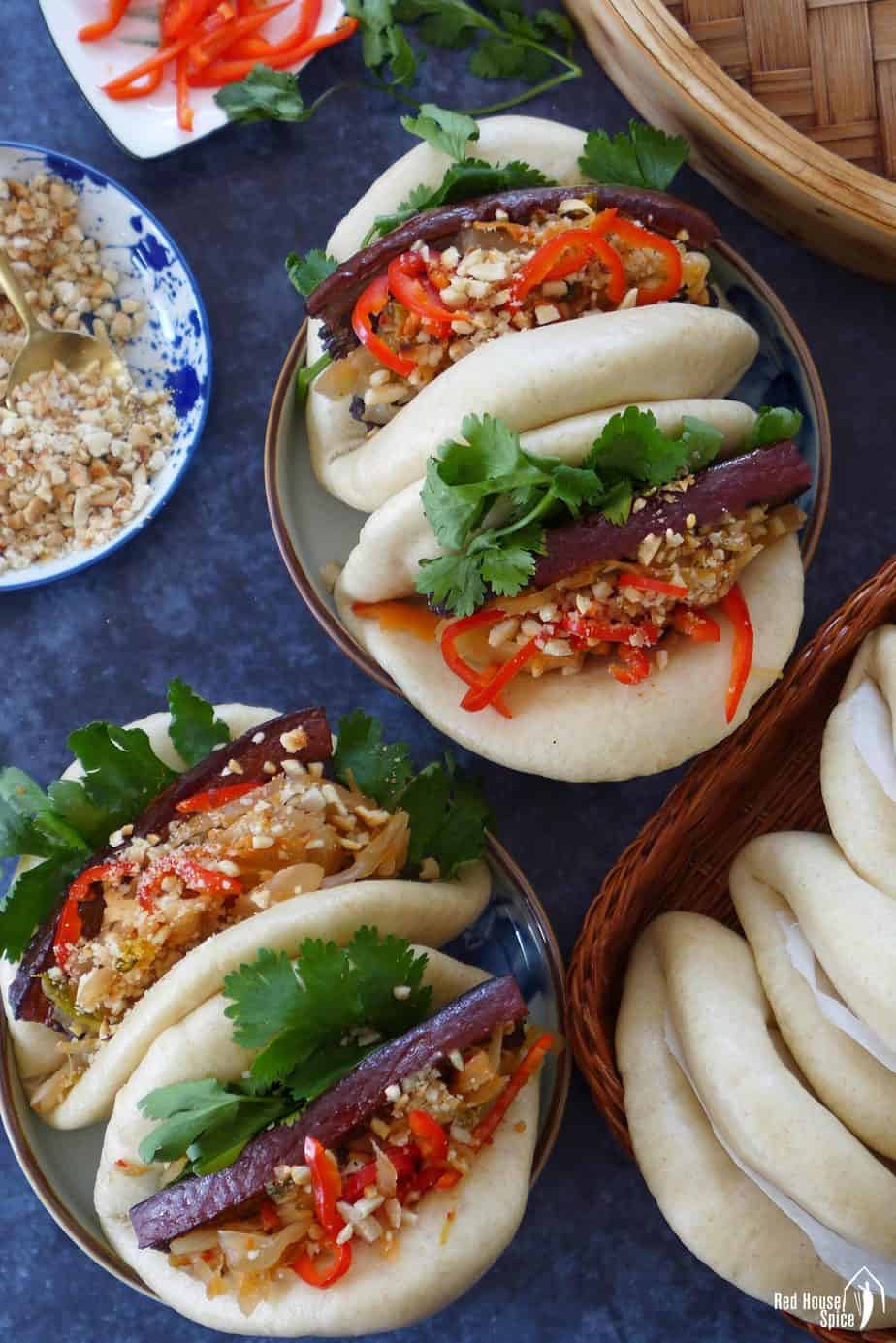
There are so many delicious food items that can go into these soft, fluffy bao buns. I encourage you to mix and match without feeling confined to any set ideas.
In general, you can combine any of the following items to fill these buns:
- Proteins: cooked meat (pork, beef, lamb, chicken, duck); cooked fish or seafood; cooked or ready-to-eat tofu slices, fried eggs or omelette, etc.
- Vegetables: lettuce leaves, carrots, cucumber, onion, bell pepper, chili pepper, etc.
- Fermented food: pickled mustard greens, kimchi, etc.
- Sprinkles: sesame seeds, toasted nuts, chili flakes, etc.
- Herbs: scallions (green onions), cilantro, basil, etc.
- Sauces: chili oil, pickled chili garlic sauce, black bean sauce, etc.
For inspiration, here are some examples:
- Follow my recipe for Gua Bao to make the classic Taiwanese version with braised pork belly (see image above).
- Use these bao buns, instead of duck pancakes, to wrap Aromatic Crispy Duck (see image below), sliced Peking duck, or roast five-spice chicken/smoked chicken.
- Flavorful, saucy stir-fries, such as Sichuan garlic sauce pork, Peking shredded pork, would make great fillings.
- Fill them with braised beef shank, along with chili pepper and lettuce leaves (see image below).
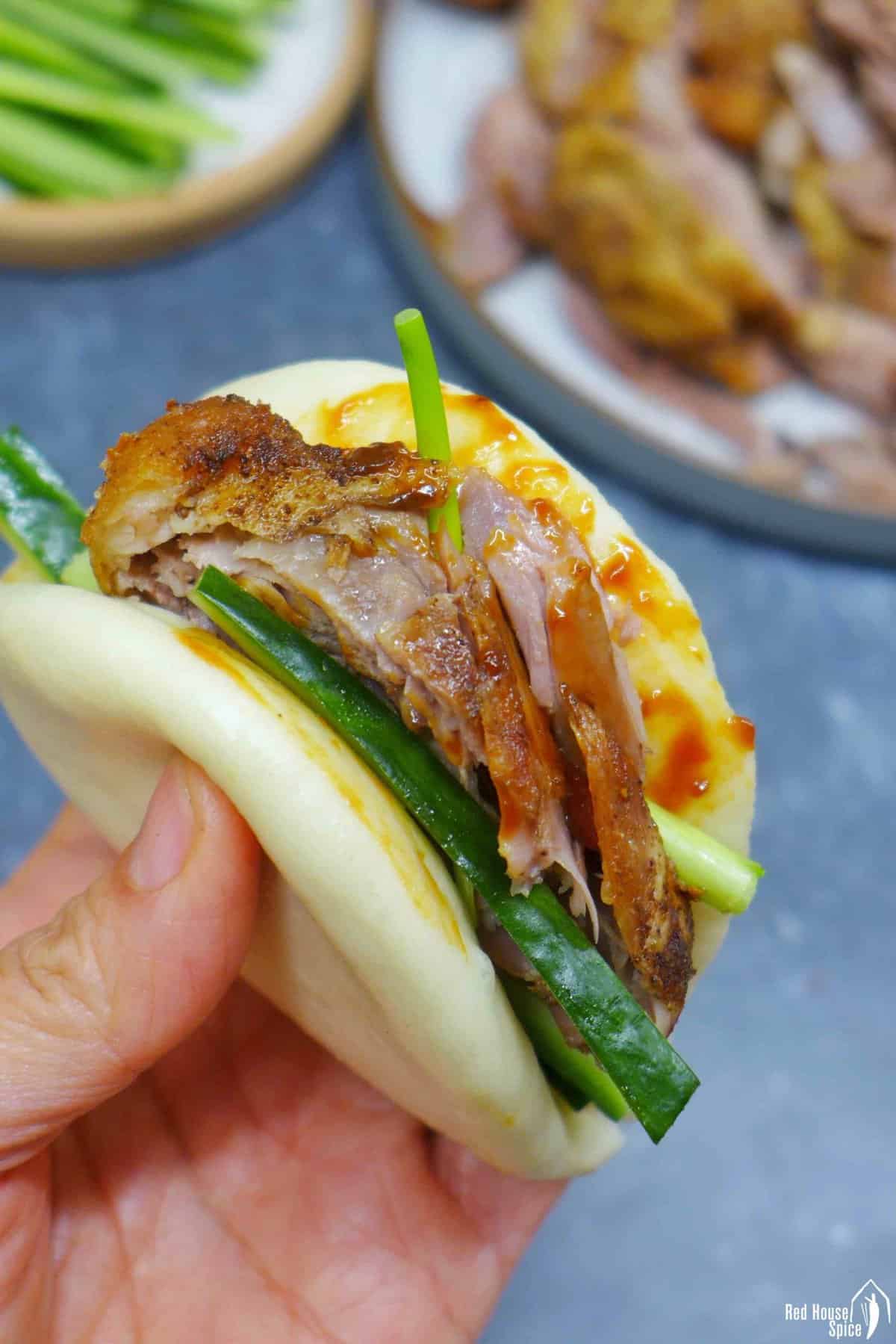
Recipe FAQs (Troubleshooting)
Based on the questions I’ve received regarding dough making, I take this opportunity to list my answers:
A: Yes, all-purpose flour in some countries, such as Canada, Switzerland, etc, has 13g or more protein per 100g of flour. In this case, replace ⅕ of the flour with cornstarch for a fluffier texture.
A: Whole-wheat flour doesn’t work well for this recipe. But you can use it to substitute ⅓ of the all-purpose flour. Adjust the water/milk quantity if necessary.
A: You can’t omit yeast for this recipe. However, you can skip baking powder and use the yeast-only method explained in my recipe for Baozi (Steamed Pork Buns).
A: That is because flour of different brands and types has slightly different water absorption capacities. Knead in a little more water if the dough is too firm. Add more flour if it appears to be overly soft.
Also, this could be caused by inaccurate measuring of flour. Using a kitchen scale is the most reliable method.
A: After the initial kneading to form a rough-looking dough, rest it for 10 minutes then knead again. This way it’s much easier to achieve a smooth dough than to keep kneading without resting.
A: This means your buns aren’t proofed long enough. The proofing time suggested in my recipe is a guide rather than a strict rule as the room temperature affects the proofing process. If it’s cooler than 72°F (22°C) in yours, extend the time a little and vice versa.
A: There are two possible causes: 1. The dough hasn’t been well kneaded causing uneven air distribution. 2. The buns have been over-proofed. Try to reduce the resting time a little next time (please refer to the question above).
📋 Recipe
Love this recipe? Please leave a 5-star 🌟🌟🌟🌟🌟 rating in the recipe card below & if you REALLY like it, consider leaving a comment as well!
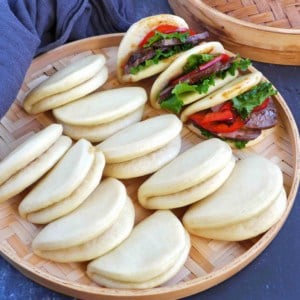
Bao Buns, A Foolproof Recipe
BEFORE YOU START
EQUIPMENT
- 1 mixing bowl (or a stand mixer with a dough hook)
- 1 steamer (with steamer basket liners)
- 1 Rolling Pin
- 1 large round biscuit cutter (optional)
Ingredients
- 300 g all-purpose flour - see note 1 for substitutes
- 1¼ teaspoon instant yeast - see note 2 for substitutes
- 1 teaspoon baking powder
- 1 teaspoon white sugar
- 165 g lukewarm water, or milk - see note 3
- Oil - for brushing
Instructions
Prepare the dough
- Manual Method: In a large bowl, mix flour, instant yeast, baking powder and sugar (see note 2 if using dry active yeast or fresh yeast). Gradually add water/milk while stirring with chopsticks. Combine and knead by hand until a rough-looking dough forms. Rest for 10 minutes then knead for 2-3 minutes until it becomes very smooth.
- Stand-mixer Method: Add flour, instant yeast, baking powder, sugar and water/milk to the mixing bowl (see note 2 if using dry active yeast or fresh yeast). Mix and knead with a dough hook on low speed for 8-10 minutes until a smooth dough forms.
Shape the bao buns
- Rolling pin method: Roll the dough into a rope. Divide into 8-12 equal pieces. Roll them into balls then flatten each with a rolling pin into an oval shape, about ⅕ inch (½ cm) thick (dust with flour when necessary to prevent sticking). Brush a thin layer of oil over half of the oval then fold over lengthways.
- Cutter method: Flatten the dough with a rolling pin into a rectangle, about ⅕ inch (½ cm) thick. Use a large round cutter to cut out circles, then roll each piece into an oval shape. Combine the leftover dough and repeat to cut out more (dust with flour when necessary to prevent sticking). Brush oil over half of the oval then fold over lengthways.
Rest
- Line the steamer baskets with perforated parchment paper or silicone steamer liners (or oil the surface if using metal or plastic steamers). Place the bao buns over leaving enough space in between for expansion.
- Leave to proof for about 30 minutes (see note 4) until the buns become a little bigger, plumper and feel lighter in weight.
Steam
- Add 2 cups (500ml) of water to the wok or pot that you use for steaming. Place the baskets on top (you may stack up several and cook all at once). Cover with a lid.
- Firstly, cook over high heat. As soon as the water starts to boil (when you see steam coming out through gaps), turn the heat to medium-low. From this moment, steam for 10 minutes.
Store
- Once completely cool, store leftover buns in the fridge for up to 4 days or in the freezer for 2 months. Reheat by steaming them for 5 minutes if chilled or 7 minutes if frozen.
Make ahead
- Cook them as instructed above then freeze them once cooled (It’s not recommended to freeze uncooked bao buns as the yeast dough doesn’t rise properly after freezing).
- Defrost them in the fridge overnight then steam for 5 minutes before serving. Or, reheat them without defrosting for 7 minutes.
Video
NOTES
NUTRITION
NUTRITION DISCLOSURE: Nutritional information on this website is provided as a courtesy to readers. It should be considered estimates. Please use your own brand nutritional values or your preferred nutrition calculator to double check against our estimates.



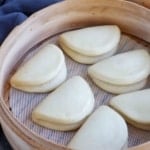

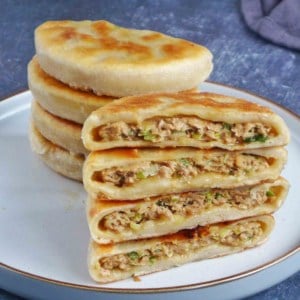
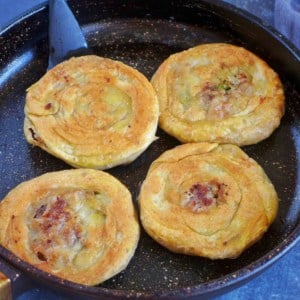
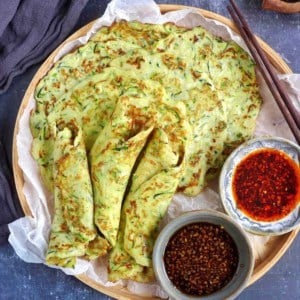

Hi wei
Your recipe have yeast and baking powder.so no need double proofing
Correct ?
My understanding is that using this recipe .I can freeze them after resting
No need to steam them first.am I correct?pl let me know
You’re correct, Jessie, that there is no need to double proof as the recipe uses both yeast and baking powder. However, I don’t recommend you freeze uncooked buns. As I mentioned in the section “Make Ahead”, steam the buns then freeze them once completely cool. Steam for a short while to reheat (no need to defrost). They’ll be as fluffy as fresh ones.